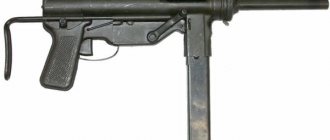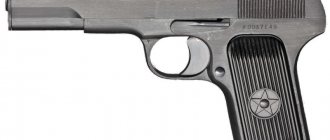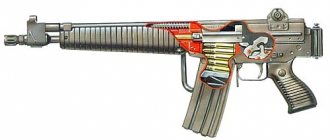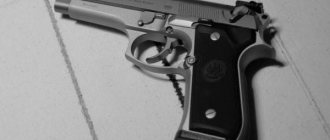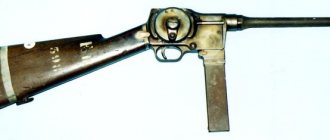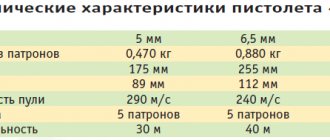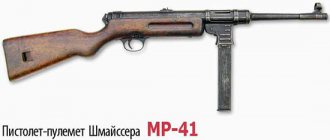Beretta submachine gun Model 12 and Model 12S (PM12, PM12S) (Italy)
Beretta Model 12 submachine gun with folded stock.
Beretta Model 12S submachine gun with folded stock.
Beretta M12s - partial disassembly.
Characteristics
Caliber:
9x19mm Luger/Parabellum
Weight:
3.2 kg
Length (stock folded/opened):
418 / 660 mm
Barrel length:
200 mm
Rate of fire:
550 rounds per minute
Magazine capacity:
20, 32 or 40 rounds
Effective range:
150-200 meters
The famous Italian arms company Pietro Beretta began developing submachine guns shortly after the First World War, and by the Second World War it released the magnificent M1938 submachine gun, which went through a number of modifications and was produced after the war for arming the police. However, even in the M1938/49 modification, this pistol ceased to meet the requirements by the beginning of the fifties, and the company began to develop a more compact and cheaper submachine gun. In 1953, the first experimental prototype of the Model 6 appeared, combining the main features of the future serial submachine gun - a stamped receiver and a bolt, in which most of the mass was located in front of the bolt cup, above the barrel. In 1957, experimental Models 10 and 11 appeared, which differed from the future production model only in small details. The final version, Model 12, was developed in 1958, and in 1959 the company launched its mass production. In 1961, the Beretta Model 12 submachine gun was adopted by the Italian Army, Police and Carabinieri. Soon, active export deliveries of the Model 12 began; licenses for the production of this submachine gun were acquired by Brazil and Indonesia. In the early 1980s, the Model 12 was modernized - the main changes affected the safety and trigger mechanism, and a number of design changes were also made to the technological plan. The modified version was designated Beretta Model 12S (PM12S) and is still in mass production.
The Beretta Model 12 (PM12) submachine gun is built according to the blowback design. The fire is fired from an open bolt, the firing pin is rigidly mounted on the bolt mirror, which for most of its length runs onto the breech of the barrel. The PM12 is equipped with an automatic safety in the form of a button on the handle located under the trigger guard, as well as a push-button non-automatic safety. The fire mode selector also had the form of a transverse button. A later modification, PM12S, has a three-position lever safety switch for fire modes (it is possible to fire in bursts or single shots). The receiver, along with the magazine neck and two handles, is made by stamping from steel, then the two halves (left and right) are connected by welding. The butt can be metal folding to the side or fixed wooden. In the front of the weapon there is an additional front handle for holding the weapon. The charging handle is located on the left front of the receiver. The PM12 is distinguished by good stability when firing and, as a result, good firing accuracy, as well as fairly small dimensions.
History and development
In 1959, Beretta gun designer Domenico Salza reworked an old design for the Armaguerra Cremona OG44 submachine gun to make a new submachine gun to replace the old MAB 1938 model. The Model 12 was the last production model, followed ten years later by the M12S, which featured safety and other mechanical features.
Its production began in 1962 and the first users were Carabinieri and Polizia di Stato, although in limited quantities, it was only in 1978 that it became widely supplied and replaced the old Beretta MAB. In 1962, the Italian Army purchased a limited number of Franchi LF-57 submachine guns, which were considered superior to the M12, but were never supplied to troops, and it was not until 1992 that the M12S2 variant was introduced in very limited numbers. Instead, Aeronautica Militare purchased a large number of M12 and M12C2 submachine guns for airport security units. However, at first these weapons had great success in Arab countries and South America. Its baptism of fire came during the Tet Offensive in 1968, when Marines guarding the US Embassy in Saigon repelled a Viet Cong attack with a Beretta M12. It is also used in various countries in South America and Africa [2] and is also manufactured under license in Brazil by Taurus and in Indonesia by PT Pindad.
Submachine gun "Beretta" PM 12
The bloody attack in Rome continued the numerous list of actions carried out by terrorists using one of the best examples of Italian small arms - the 9-mm Beretta RM.12 submachine gun, created specifically for the fight of law enforcement agencies against criminals.
The day of March 16, 1978 entered the modern history of Italy as a black date that radically changed the entire course of the political life of the state. On this day, the new Italian coalition government of Giulio Andreotti, formed by the Christian Democratic Party and the Italian Communist Party, had to appear before parliament to receive its approval. However, this chance for national reconciliation of right and left was destroyed by militants from the Maoist Red Brigades, who kidnapped in Rome the chairman of the national council of the Christian Democratic Party, Aldo Moro, thanks to whom an agreement was signed between the Italian center and left parties to create a parliamentary majority.
options
The first variant was introduced in the late 1960s in limited numbers to the Marina Militare special forces and is easily recognizable by its longer barrel with an additional 25.4 mm and the presence of a cage-type flash suppressor. It was replaced by the HK MP5.
Beretta M12 was redesigned as Beretta M12S
in 1978. The M12S uses a 32-round magazine and fires 9 x 19 Parabellum ammunition.
A new feature is the pistol grip safety, which locks the trigger and bolt in the closed position, thereby preventing accidental discharge if the pistol grip is not held tightly or if the weapon is dropped to the ground. The safety lever and fire selector, which on the original Beretta M12 were two separate buttons (the selector was a button that activated semi-automatic mode and automatic mode when pressed to the right or left), have been redesigned into a modern lever. selector lever with three positions (S for Sicura
or Seguro, 1 for semi-automatic mode and R for
Raffica
or automatic mode). The fixed firing pin of the bolt head can only strike the primer. when the cartridge is completely inside the chamber, which, according to its designers, avoids an accidental shot.
The PM12S has also been designed with easy disassembly and reassembly in mind, which has been simplified and can be done without tools .
It can be fitted with a suppressor, but this requires minor modification of the barrel by an experienced gunsmith.
Without a silencer or other additional features, the Beretta PM12S consists of 84 parts.
The current version of the Beretta M12 is called PM12-S2
.
In the mid-1980s, the Carabinieri, after several tragic accidental discharges, requested a modification in the form of an additional safety, which allowed the weapon to be held in the half-cocked position and acted as an interceptor, preventing accidental discharge. in case of sudden release of the bolt or firing pin. This modification was implemented as a standard production feature, changing the submachine gun designation to PM12-S2
; it is the only variant of the M12 currently produced by Beretta.
Contact CIA
The Office of Public Affairs (OPA) is the single point of contact for all inquiries about the Central Intelligence Agency (CIA).
We read every letter, fax, or e-mail we receive, and we will convey your comments to CIA officials outside OPA as appropriate. However, with limited staff and resources, we simply cannot respond to everyone who writes to us.
Contact Information
By postal mail:
Central Intelligence Agency Office of Public Affairs Washington, DC 20505
Before contacting us:
Please check our site map
,
search
feature, or
our site navigation on the left
to locate the information you seek. We do not routinely respond to questions for which answers are found within this Web site.
Employment:
We do not routinely answer questions about employment beyond the information on this Web site, and we do not routinely answer inquiries about the status of job applications. Recruiting will contact applicants within 45 days if their qualifications meet our needs.
- Because of safety concerns for the prospective applicant, as well as security and communication issues, the CIA Recruitment Center does not accept resumes, nor can we return phone calls, e-mails or other forms of communication, from US citizens living outside of the US . When you return permanently to the US (not on vacation or leave), please visit the CIA Careers page and apply online for the position of interest.
Ratings
- ↑ a b c d e f g h i j k
Miller, David (2001).
An Illustrated Guide to 20th Century Weapons
. ISBN Salamander Books Ltd. 1-84065-245-4. - ↑ a b c d e f g h i j k l m n ñ o p q r s t u Gander
, Jerry (2002).
Jane's Infantry Weapons 2002–2003
. Jane Information Group. p. 214, 899–906. ISBN 0-7106-2434-4. - Hogg, Ian; Weeks, John (2000). Military small arms of the twentieth century
. Iola, WI: Krause Publications. p. 139. ISBN 0-87341-824-7. - Long, Duncan (1986). Assault pistols, rifles and submachine guns
. Boulder, CO: Paladin Press. paragraph 17. ISBN 0-87364-353-4. - ^ a b
"Archival copy". Archived from the original on October 11, 2007. Retrieved September 16, 2008 - ↑ a b
Diez, Octavio (2000).
Weapons and equipment: Pistols
. Lem Publications, SL ISBN 84-8463-013-7. - "Hunt for terrorism suspects in France". Image 15 shows a French policeman with a pistol. Retrieved January 9, 2015.
- "Review of Pindad's Light Weapons". WEAPON . Retrieved July 5, 2010.
- Meir, Eitan (6 January 1999). "Special weapons for counter-terrorism units". Jane - law enforcement. Archived from the original on March 1, 2008. Retrieved September 26, 2009.
- Carabinieri - Weapon - Beretta M12. Archived November 9, 2014, at the Wayback Machine.
- Italian Parliament, Session 46, Report of the Minister of the Interior (broken link available at Internet Archive; see history, first and last version).
- Ryder, Chris (2005). Special Courage: 321st EOD Squadron - Anti-Bomber Fighting
. Methuen. p. 228. ISBN 978-0-413-77223-7.
Users
The officers are carabinieri squadron Eliportato Carabinieri
(Carabinieri helicopter squadron), armed with Beretta M12 submachine guns. Beretta M12 with the stock extended.
- Saudi Arabia [2]
- Algeria [2]
- Bahrain [2]
- Belgium Manufactured under license from FN Herstal [2]
- Brazil: Manufactured under license by Taurus under the designation Taurus MT12
.
[5] [] Standard submachine gun of the Brazilian Army, designated M972
. [ 2 ] [ ] - Chile [2]
- Vatican [2]
- Costa Rica [2]
- Egypt [2]
- USA: Works for the CIA and some special forces. [2]
- France Serves in the police. [7]
- Gabon [2]
- Guatemala [2]
- Guyana [2]
- Indonesia: Produced under license. [ 2 ] [ ] PT Pindad produces models PM1 and PM1A1. [ 8 ]
- Iran [2]
- Italy: Used by all armed forces and police: special units GIS and NOCS, [9] Carabinieri, [10] Marina Militare, Aeronautica Militare, Polizia di Stato, Guardia di Finanza, Polizia Penitenziaria. and Corpo foreste dello Stato. [ eleven ]
- Libya [2]
- Malta: Armed Forces of Malta. [ 12 ]
- Nigeria [2]
- Portugal: The Brazilian model Taurus MT12 is the standard submachine gun of the Polícia de Segurança Pública [2]
- Sudan [2]
- Tunisia [2]
- Venezuela [2]
- Provisional Irish Republican Army: Supplied by the IRA from Libya and used in various ambushes. [ link needed
]

